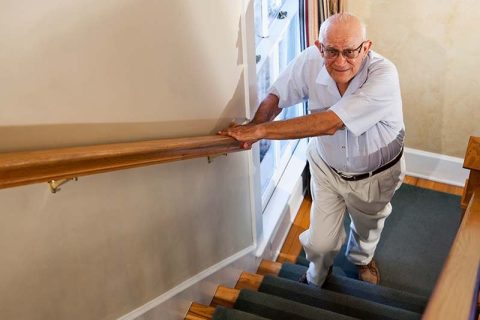June 2, 2022 by

Benjamin Franklin hit the nail on the head: An ounce of prevention really is worth a pound of cure. When it comes to detecting and addressing mobility issues in seniors, prevention is crucial. Falls in seniors lead to 300,000 hip fractures, 3 million emergency room visits, and 32,000 deaths each year, according to the CDC.
Avoid an emergency by staying aware of these warning signs of increasing mobility issues in seniors:
- Struggling to sit or stand. Notice whether the senior finds it difficult to either stand up from a seated position or to sit back down. Do they require something to hold onto for support?
- Steering clear of stairs. A senior who seems to be getting around just fine but is avoiding going up or down stairs may be fearful of falling due to mobility changes.
- Experiencing dizziness. Dizziness and problems with balance can arise from a plethora of causes that ultimately cause difficulty with mobility. It’s important to find out why these issues are occurring and address them immediately.
- Skipping physical activity. Another red flag is a senior who previously engaged in some degree of exercise but now is choosing a more sedentary lifestyle. Weakness or exhaustion can lead to problems with mobility.
A simple yet effective way to monitor mobility and fall risk in seniors is the TUG (Timed Up and Go) test. The test should be performed on a regular basis. Here’s all it takes:
- Place a sturdy chair against the wall.
- Mark a distance of 10’ from the wall.
- Have the senior sit in the chair.
- When you tell them to go, start a timer, and have the person stand, walk to the 10’ mark, turn around, come back and sit down again.
Stand close by as the senior performs the test to ensure their safety and to offer support if needed. Track the results over a period of time and share with the person’s doctor for guidance. Find additional information on the test as well as a downloadable one-page assessment sheet.
If you notice any of the telltale signs, it is most likely time to broach the issue with the aging loved one. Let the person know you’re concerned, and schedule an appointment for a check-up with the doctor. The implementation of some simple mobility aids can make a world of difference in maintaining safety and independence.
Contact At Home Independent Living online for additional fall prevention tips for seniors, and to learn about the many ways we can help improve quality of life for a senior you love.
